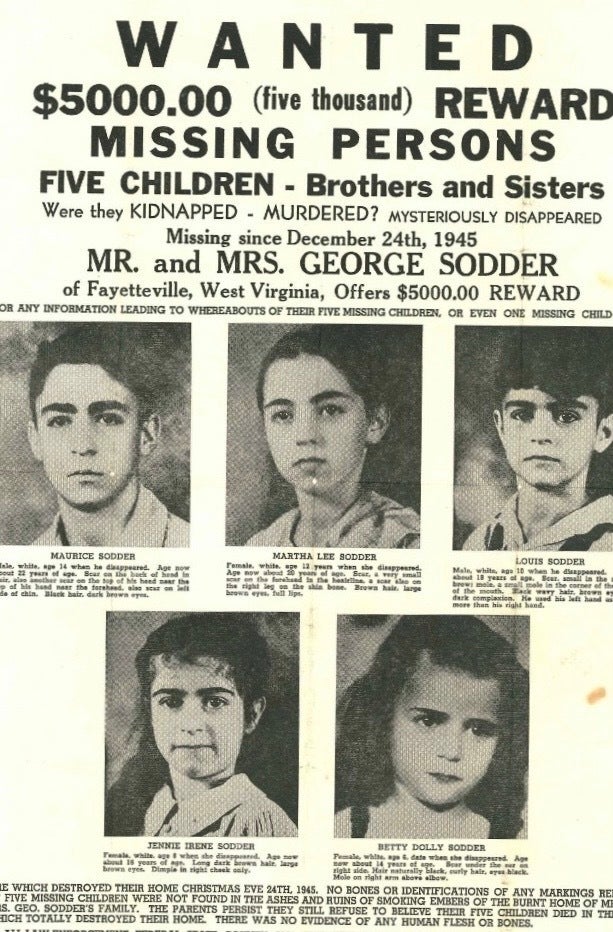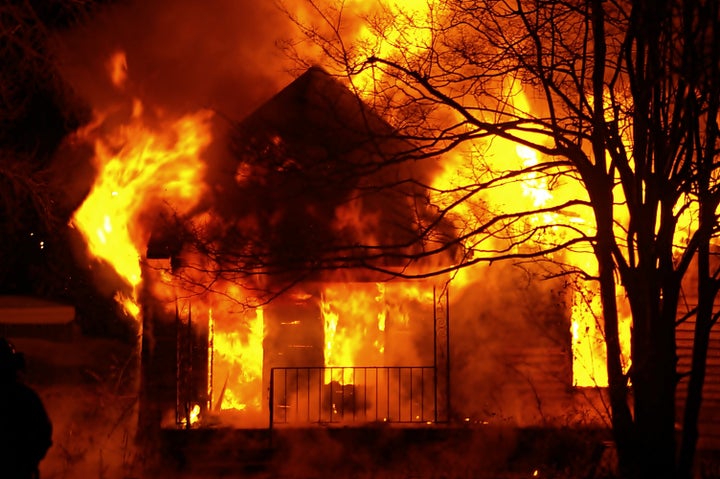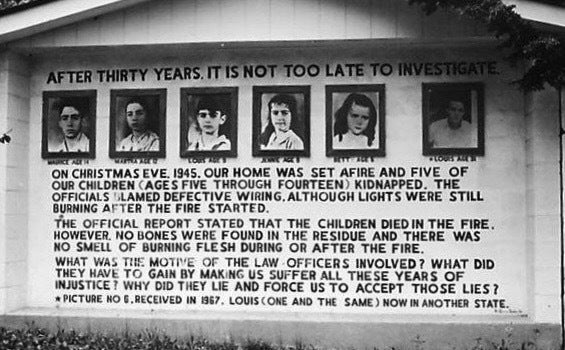This is an excerpt from our true crime newsletter, Suspicious Circumstances, which sends the biggest unsolved mysteries, white-collar scandals, and captivating cases straight to your inbox every week. Sign up here.
Just after midnight on Christmas Eve in 1945, Jennie Sodder awoke to the smell of smoke. She quickly discovered that the Fayetteville, West Virginia, home she shared with her husband, George, and nine of their children, was ablaze. When the fire department arrived seven hours later, the two-story framed house had burned to the ground — and five Sodder children were missing.
No one can say for certain what happened to the Sodders’ five young children, but their family never saw them again, and their remains were not found in the ashes of their home.
Although authorities determined that the children — Maurice, 14; Martha, 12; Louis, 10; Jennie Irene, 8; and Betty, 5 — had died in the fire, their family disputed the finding and never gave up searching for them. Because of so many peculiar events surrounding the tragic fire, the case captured the public imagination and is one of the greatest mysteries of the 20th century.

The siblings’ older brothers, John, 23, and George Jr., 16, and their father had gone to bed early that Christmas Eve, tired from a long day working at George’s coal trucking business. The younger children, however, were allowed to stay up late to play with the toys their older sister, Mary Ann “Marion” Sodder, 17, had bought them for Christmas. Their mother took the youngest child, 3-year-old Sylvia, to bed with her at around 10:30 p.m., telling Maurice and Louis to attend to the cows and chickens.
Joe Sodder, 21, had been discharged from the Army the day before the fire and was the only one of the 10 Sodder children not home.
At about 1 a.m., Jennie bolted out of bed when she smelled smoke and saw flames in her husband’s office, blocking her from reaching the phone. She told Marion, who had fallen asleep on the sofa, to take Sylvia outside while she and George frantically tried to rescue the other children. George Jr. and John, who said he woke his siblings — but later updated his account, saying that he had only shouted at them — ran downstairs. Fire engulfed the staircase to the attic where the children slept, preventing their father from going upstairs. The fact that no one heard them crying out was one of the reasons the Sodders later believed they might not have been in their bedroom at all.
At the time, however, George desperately tried other ways to get to his children. He was stymied by two of many unusual circumstances that night. First, a ladder that normally stood by the house wasn’t there. He and his sons then tried to move his trucks against the house, hoping to reach the upper floor by standing on top of them, but they couldn’t get them started.
They could only watch as the blaze destroyed the five-room house. After 45 minutes, only its foundation remained.

Telephone Sabotage
Even if Jennie had been able to reach the family’s telephone, she couldn’t have placed a call: The line had been cut. George Bragg, a local writer and researcher, told NPR in a 2005 interview that a man later admitted that he had cut them — and during the fire was in an outbuilding on the Sodders’ property stealing a block and tackle (used to remove car engines). While there is speculation that he set the fire as a diversion, it’s also possible he took advantage of the family’s distraction to take the equipment. Still, neither the thief nor anyone else was ever charged with arson in the catastrophic fire.
“The Lights Were Still Burning”
Officials initially determined that the fire had been caused by faulty electrical wiring, another finding the family disputed. It couldn’t have been an electrical fire, the Sodders believed, because they could see some lights on in the rooms downstairs before the fire consumed the house. Moreover, George had recently hired a professional electrician to do some work, and it had passed an inspection — evidence to him that something else had sparked the blaze.
Crank Call
The phone was working just after midnight, Jennie later said. Its ringing was the first of three separate events, including the smoke, that had awakened her. The caller asked to speak to someone Jennie didn’t know. After she replied that they must have the wrong number, the caller responded with what Jennie described as a strange laugh.
Thump On The Roof
Half an hour later, Jennie heard “something like a rubber ball” hit the roof. “It rolled and hit the ground with a thump,” she said.
At the time, it didn’t worry her, and she fell back asleep again. But a passing bus driver (or passenger ― the attribution is inconsistent) described having seen “balls of fire” being thrown on the tar and wood roof, where it was determined the blaze had started. Sylvia later found a rubber object in the yard, the family claimed, that George identified as a type of hand grenade.

Firefighters’ Delay
Marion reportedly ran to a neighbor’s home to summon the fire department, but the phone operator failed to respond to her call or a second one placed by another neighbor. George attempted to fill a bucket with water to douse the fire himself. Unfortunately, due to the frigid weather, the water barrel was frozen solid. And they received no help from the fire department — their truck didn’t respond until daylight, seven hours after another neighbor called them. Various accounts attribute the delay to a war-related staffing shortage, and difficulty in contacting and rousing the firefighters. It is also rumored that the chief didn’t know how to operate the fire truck and had to wait for someone who could drive it.
Missing Remains
Death certificates for the children were issued on Dec. 30, five days after the fire. The cause of death for each was listed as “fire or suffocation.” Although George and Jennie Sodder later insisted otherwise, a journalist who covered the story for NPR said four people had reported seeing remains — including one of Jennie’s brothers. If so, they weren’t collected or included in official records.
George Sodder himself may have unintentionally destroyed evidence that his children had died. On Dec. 29, he brought in a bulldozer to fill the basement with dirt in order to create a memorial for them. At the time, the grieving family did not doubt the officials’ determination that the five children did not survive. Only later would John reportedly admit that he hadn’t actually seen or heard his five siblings respond when he warned them to escape as he and George Jr. fled.
In the “burial, cremation, or removal” section of the children’s death certificates, “burial” is selected with the date of Dec. 27. The Sodders’ address is listed as the “cemetery.”
Buried Beef Liver
One of the most bewildering elements of this story involves Fayetteville Fire Chief F.J. Morris. Accounts vary, but according to a private investigator hired by the Sodders, Morris said he had found a body part — specifically, a heart — at the site and buried it there in a box. The box was dug up and taken to a funeral director. He swiftly determined that rather than a human heart, the box contained what he believed to be beef liver, untouched by fire.
Morris allegedly told others that he’d planted the fake remains to persuade the Sodders their children were dead — a baffling explanation considering the parents were never told about it.
In 1949, George Sodder had the site excavated and made a stunning find: human vertebrae. However, there was no way to prove the bones were there right after the fire. They could have been transferred, for example, in the soil George’s bulldozer used to fill in the basement.
The vertebrae ― which had no evidence of charring ― were sent to the Smithsonian Institution for analysis. It found that they belonged to a single individual, likely a male between the age of 16 and 22. The report stopped short of excluding Maurice, the 14-year-old, saying it was “possible, although not probable,” for a boy his age to have the skeletal maturation of a 16- or 17-year-old.
Supposed Sightings
Frustrated by officials’ unwillingness to further investigate their children’s disappearance, the Sodders hired a number of private investigators, and George himself traveled around the country following up on leads. Their theory that the children were kidnapped — by the Mafia, or others — was bolstered by a number of alleged sightings throughout the years. For example, a Charleston motel manager came forward in 1952 to say that four children, accompanied by two men and two women, whom she described as of “Italian extraction,” stayed overnight at her establishment “two or three days” after the fire. The Sodders found her account credible enough that they included it in a billboard they erected in 1953 at the site of the fire, offering a $5,000 reward ― later doubled ― “for information leading to the recovery of any one or all 5” of the missing children.
“What Was Their Fate: Kidnapped, Murdered or Are They Still Alive?” the billboard read above individual photos of each child.
A number of other witnesses came forward as well. One woman said she saw the children in a passing car while the fire was still burning; another claimed she served them breakfast at a diner just hours later. Perhaps the most convincing lead arrived in a mailed envelope addressed to Jennie Sodder in 1967.

“Louis” Picture
Inside the envelope, postmarked from Central City, Kentucky, was a photograph of a man who looked strikingly similar to Louis. Handwritten on the back of the photo was “Louis Sodder” followed by a cryptic message: “I love brother Frankie. Ilil boys. A90132 or 35.” The Sodders were convinced it was their son, but they and other investigators could not decipher the message. Louis did not have a brother named Frank, but his mother — born Jennie Cipriani — did. In fact, at one point the Sodders accused a man named Frank Cipriani of kidnapping the children and raising them as their own in Florida. (The woman who claimed to have seen the children on Christmas morning noticed the car had a Florida license plate, and Cipriani lived in the area where other witnesses said they saw the children.) According to Cipriani’s obituary, one of his three sons was also named Frank.
The “Ilil boys” phrase has sleuths stumped, but many have pointed that the five digits in “A90132 or 35” could represent postal codes — 90135, for example, can be found in the city of Palermo, the capital of the Italian island of Sicily.
In 1967, the Sodders reportedly received a letter from a woman in Houston who said she encountered Louis and his brother Maurice at a bar, where Louis “confessed” that they were the missing Sodder brothers. Sylvia’s husband, Grover Paxton, drove George there and met with the men, but they denied they were his sons.
“I think there was always some doubt in his mind,” Paxton told the Charleston Gazette-Mail. “He died shortly thereafter, in 1969, and I think he always wondered if those were his boys.”
“Somebody stole them, that’s what,” Jennie told the Beckley Post-Herald in 1975 about her missing children. She had a second billboard created to include the photo she believed to be an adult Louis. The message was unequivocal, stating the children had been kidnapped and questioning why the police failed to investigate.
In an interview with the Charleston Daily Mail in 1976, Jennie said, “Nothing is going to get me to give up hope that my children are still alive.”
Jennie died in 1989, but her surviving relatives and amateur detectives continue to search for clues about what happened to her children. It’s possible the mystery will never be solved.
